
Glenmore Homestead is a heritage-listed homestead at Belmont Road, Parkhurst, Rockhampton Region, Queensland, Australia. It was built from c. 1858 to c. 1920. The homestead and associated buildings once belonged to pastoral run on the Fitzroy River, seven kilometres northwest of Rockhampton, Queensland. Originally much larger at 127 square miles the current size of the property is 20 acres (8.1 ha). It was added to the Queensland Heritage Register on 21 October 1992.

Canning Downs was the first residential establishment built by a white person on the Darling Downs in Queensland, Australia. It is located a short drive from the town of Warwick and originally extended south east to Killarney and the McPherson Range. The area was first named after the British statesman George Canning by Allan Cunningham.

Rodway is a heritage-listed villa at 2 South Street, Rangeville, Toowoomba, Toowoomba Region, Queensland, Australia. The architect was Harry Marks. It was built from c. 1904 to 1930s. It is also known as Sylvia Park. It was added to the Queensland Heritage Register on 21 October 1992.
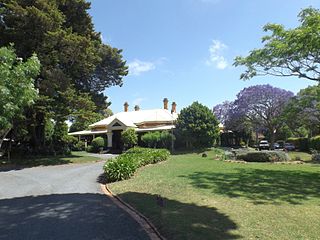
Vacy Hall is a heritage-listed villa at 135 Russell Street, Toowoomba, Toowoomba Region, Queensland, Australia. It was built c. 1899. It was added to the Queensland Heritage Register on 21 October 1992.

Franklyn Vale Homestead is a heritage-listed homestead at Franklin Vale Road, Mount Mort, City of Ipswich, Queensland, Australia. It was built in the early 1870s. It was added to the Queensland Heritage Register on 21 October 1992.
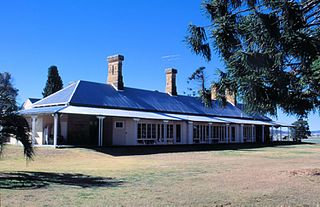
Talgai Homestead is a heritage-listed homestead at Allora, Southern Downs Region, Queensland, Australia. It was designed by architect Richard George Suter for Queensland pastoralist and politician George Clark and was built in 1868. It was added to the Queensland Heritage Register on 21 August 1992. It is also known as East Talgai Homestead to distinguish it from the West Talgai Homestead built by Clark's brother, Charles Clark.

Ballandean Homestead is a heritage-listed homestead at Ballandean, Southern Downs Region, Queensland, Australia. It was built from c. 1840 to 1890s circa. It was added to the Queensland Heritage Register on 21 October 1992.

Cressbrook Homestead is a heritage-listed homestead at off Cressbrook-Caboombah Road, Cressbrook, Somerset Region, Queensland, Australia. It was built from 1841 to 1914. It was added to the Queensland Heritage Register on 21 October 1992.

Kilcoy Homestead is a heritage-listed homestead at Kilcoy-Murgon Road, Winya, Somerset Region, Queensland, Australia. It was built c. 1857. It was added to the Queensland Heritage Register on 21 October 1992.
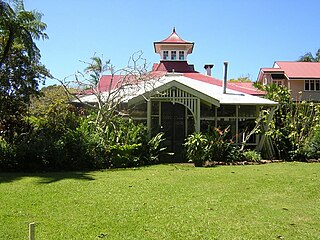
Buderim House is a heritage-listed homestead at 10 Orme Road, Buderim, Sunshine Coast Region, Queensland, Australia. It was designed by George Trotter and built c. 1915 by Christian Schriver. It was added to the Queensland Heritage Register on 2 March 1993.

Booubyjan Homestead is a heritage-listed homestead at Booubyjan Road, Booubyjan, Gympie Region, Queensland, Australia. It was built from the 1860s to the 1870s circa. It was added to the Queensland Heritage Register on 21 October 1992.

Glengarry Homestead is a heritage-listed homestead at Gladstone-Monto Road, Boynedale, Gladstone Region, Queensland, Australia. It was built from c. 1894 to c. 1920. It was added to the Queensland Heritage Register on 21 October 1992.

Langmorn Homestead is a heritage-listed homestead at Langmorn Road, Raglan, Gladstone Region, Queensland, Australia. It was built from 1873 to 1926. It was added to the Queensland Heritage Register on 21 October 1992.

Gracemere Homestead is a heritage-listed homestead at 234 Gracemere Road, Gracemere, Rockhampton Region, Queensland, Australia. It was built from 1858 to 1890s. It was added to the Queensland Heritage Register on 21 October 1992.
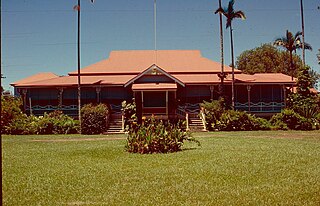
Greenmount Homestead is a heritage-listed homestead at Greenmount Road, Walkerston, Mackay Region, Queensland, Australia. It was designed by William Sykes and built in 1915 by Arthur Carter & Co. It was added to the Queensland Heritage Register on 6 September 1993.
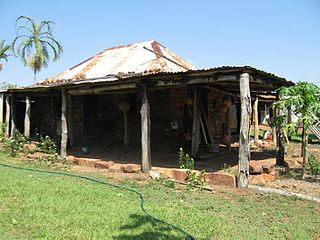
Old Westmoreland Homestead is a heritage-listed homestead at Westmoreland Station, Nicholson, Shire of Burke, Queensland, Australia. It was designed by Thomas Brassey McIntosh and built in c. 1882 by Thomas Brassey McIntosh. It was added to the Queensland Heritage Register on 31 July 2008.

Burrandowan Station Homestead is a heritage-listed homestead at Kingaroy Road, Durong, South Burnett Region, Queensland, Australia. It was built from 1848 to c. 1927. It was added to the Queensland Heritage Register on 21 October 1992.

Eidsvold Homestead is a heritage-listed homestead at Eidsvold Road, Eidsvold, North Burnett Region, Queensland, Australia. It was built in 1850. It was added to the Queensland Heritage Register on 21 October 1992.

Tarong Homestead is a heritage-listed homestead at Cooyar Road, Tarong, South Burnett Region, Queensland, Australia. It was built from 1840s circa to 1890s circa. It was added to the Queensland Heritage Register on 21 October 1992.

Boondooma Homestead is a heritage-listed homestead at Mundubbera - Durong Road, Boondooma, South Burnett Region, Queensland, Australia. It was built from the 1850s to the 1870s. It was added to the Queensland Heritage Register on 21 October 1992.
























